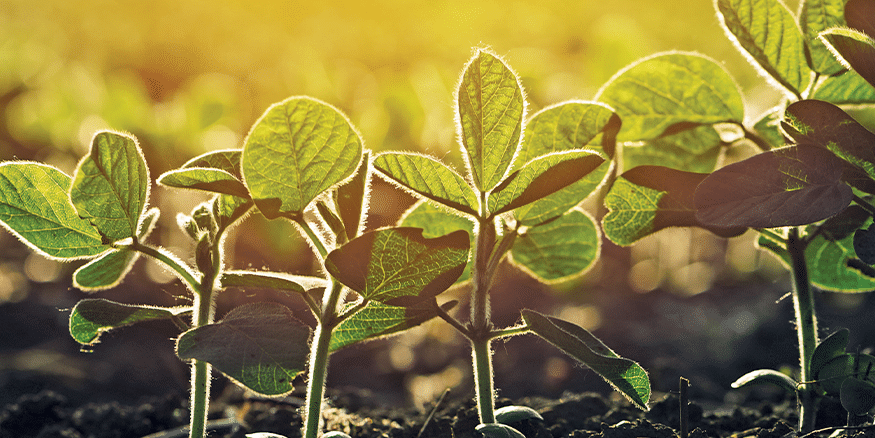
Genetically Modified Food
Note: Choosing a diet of GM foods or non-GM foods (or a combination of both), should be a personal choice, determined by an individual, with guidance from health care providers. The Gastrointestinal Society encourages readers to research which foods are the best fit for their health needs and lifestyle so they can make informed decisions about the production, ingredients, and nutritional content of their food.
What are GMOs?
Genetically modified organisms (GMOs) are created using materials that are genetically altered or enhanced. This includes the crossbreeding of an organism, the alteration of the genetics or cells of an organism, or the addition of new genetic materials or genetic therapies to an organism.1 An example of genetic modification is the introduction of the naturally-occurring Bacillus thuringiensis bacteria to corn crops, which helps the ‘Bt corn’ crops resist pests. The Bt corn contains a gene that produces a protein that is fatal to insects and, by using this modified plant, farmers can reduce the amount of pesticides they use to protect their crops, thereby reducing harmful contamination.2
Crops grown without the help of genetic modification can be more susceptible to outside forces such as pests, diseases, and adverse growing or weather conditions.3 With increasing global population and demands on farmers to increase acreage yields, they turn to genetically modified seeds. Health Canada is responsible for ensuring that GMOs are safe for human consumption by evaluating every product with a genetically modified (GM) makeup before approving the product for sale in Canada.
A recent survey conducted by Health Canada found that 78% of Canadians want appropriate labelling of GM foods and, when given a choice between buying a GM product or a non-GM product, 62% of respondents said they would buy the non-GM product.4
Selective Breeding: The Original GMOs
Between 15,000 and 10,000 years ago, humans learned to harness the power of agriculture and domestication to create better and more resilient foods to feed their communities and found they could also use selective breeding to their advantage.5 By choosing the best crops, such as corn with more kernels on its cob, and animals, such as bigger, healthier cows, farmers could continue to breed those organisms together to promote their best qualities to produce more food. Farmers continue to use these techniques today to guarantee the most successful harvest possible and to enhance plant-based food supply and livestock production.
Today, scientists at the University of British Columbia use selective breeding techniques to help strengthen the at-risk North American bee population. To help combat colony collapse, researchers are breeding genetically stronger queen bees that are less prone to illness, as well as bees that are more likely to keep the hive clean and disease-free to promote health within the colony.6 The researchers’ goals are to manipulate the bees’ breeding patterns to fight common pathogens that might harm them. Pesticide use has allowed pathogens to build more resistance and strength, thereby negatively affecting the overall health of the global bee population.
Avoiding Confusion
The issues of genetic modification, chemicals, and hormones in food production are distinctly different. If growers use genetic modification, it does not necessarily mean that they also employ pesticides or hormones in the growth process. In some cases, growers genetically modify foods to make them more resistant to certain pathogens to decrease the use of pesticides that might otherwise be necessary, as with the Bt corn example above.2
It is possible, and likely, that production methods for common GM products do not include the use of pesticides or hormones. Conversely, it is also possible, and likely, that production methods for non-GM products do include pesticides or hormones. Since the processes and procedures of these kinds of food modifications all vary, we cannot determine their safety collectively. Rather, the safety of GMOs should be determined on a case-by-case basis, separately from that of other food-modifying processes, to best assess the potential risks and benefits of any food.
Safety
To ensure they are safe for consumption, Health Canada consults with groups such as the World Health Organization and the United Nations’ Food and Agriculture Organization to test biotechnology-enhanced products before approving them.7 Since 1993, the Government of Canada has used the Canadian Federal Regulatory Framework to test the safety of what they define as ‘novel’ foods, which are products not previously used as a food or those created through genetic modification. Novel foods involve ingredients, manufacturing practices, or genetic modifications that require testing before their release, such as unpasteurized fruit juice treated with ultraviolet light to control harmful E. coli bacteria or a never-before-sold species of fish.8
Health Canada reviews the development of GM foods, the nutritional information of food products, and the potential for adverse and allergic reactions, among other things. The Canadian Food Inspection Agency helps regulate these products and their testing trials, and assesses their potential environmental impact.8 Health Canada, in conjunction with Environment Canada, works to ascertain the environmental impact of growing and producing GMOs. The concern is that if not properly evaluated, managed, and maintained, GM crops have the potential to contaminate nearby non-GM plants or otherwise impact the environment.
In 1999, researchers at Cornell University presented a study that determined monarch butterflies fed milkweed leaves dusted with Bt pollen experienced worse health than monarch butterflies that were not fed Bt pollen. However, a subsequent peer review on the subject determined that processes within the original study might have been flawed and that monarch butterflies ingesting Bt pollen in a non-controlled setting are not at risk for any notable health problems. The Canadian Food Inspection Agency implements insect resistance management plans to mitigate insect resistance to insecticides, including those produced by GM foods like Bt corn, toward managing the environmental impact of GMOs.2 As Health Canada approves more GMOs for sale, tests and regulations such as these are in place to ensure there are no measurable long-term negative effects associated with growing or consuming these products.
Nutritional Differences & Labelling
When Health Canada assesses a GM product’s safety for distribution in Canada, it looks at how the GM food compares to a non-GM version. This is to determine any differences in nutritional quality and ingredient composition and to alert consumers of any allergens that are present in the product. If the genetic modification of a product changes the ingredients enough to warrant concern over a potential irritant, then they note this change on the product’s label.8
In Canada, producers are not required to label items as GM. If they were required to labels products as such, then the labelling would be extensive and widespread, because many varied products comprise GM foods.3 Some companies voluntarily label their products as ‘GMO free’.
To learn more about the ingredients and production methods of your food, get into the habit of reading product labels, calling food producers with your questions, and doing research on companies and their business practices. You can also plant a home garden or use your local community garden to grow your own fruits, vegetables, and herbs to ensure you know the growing history. Remember to check the production history of your seeds.
Global Impact
Globally, genetic modification helps provide those in developing nations with foods that are more nutritious. For example, UNICEF estimates that vitamin A deficiency affects more than 100 million children worldwide, which can cause blindness, diarrhea, a susceptibility to disease, and an increase in mortality.9 Biofortified crops (crops that are grown using selective breeding techniques or through genetic modification) have the potential to end nutritional deficiencies worldwide. Golden Rice is one such biofortified crop, and it helps to combat childhood malnutrition in the developing world. This Golden Rice is regular rice altered to produce and contain vitamin A, which reduces the symptoms and mortality associated with the deficiency.10
Alternatives to GMOs
For those concerned about GMOs and novel foods, there are alternatives, such as buying organic. If you are interested in incorporating organic foods into your diet, look for the official ‘Canada Organic’ label as it ensures that the product is composed of at least 95% organic ingredients. It must also be non-GMO and grown by exclusively organic means, including using fertilizers and pest-killers that are of organic origin.11 It seems intuitive that organic foods are better for us, but there has been little scientific investigation on this subject. However, traces of pesticides can sometimes still be present on mass-produced foods by the time they make it onto store shelves.
All types of produce, including organic, can carry the risk of surface contamination with pathogenic microorganisms such as E. coli and Salmonella. For this reason, it is important to wash fruits and vegetables thoroughly, no matter where you purchase them or how they are grown.
Choosing the Best Foods for You
Part of becoming an empowered consumer comes from learning about the foods we have available to make the best choices for you and your family. By doing so, you can align with the production, ingredients, and environmental impact of the foods you ingest. When deciding on GMO-enhanced foods versus organic products, and those of uncertain origins, speak with your doctor and a registered dietitian to assess your options in view of your specific health needs.
GMOs Fast Facts
- Carrots were not originally orange. By the 1600s, farmers in the Netherlands figured out how to use selective breeding techniques to change the carrot’s colour from white, purple, or yellow to bright orange, which paid tribute to the Dutch Royal Family, the House of Orange. Carotenoids, the same pigment that gives the carrots we most commonly see in the supermarket their signature colour, provide us with a good source of vitamin A.12
- The first commercially available GM food was a tomato developed by Calgene Inc. in 1994. The Flavr Savr tomato, first sold in the United States, stayed fresher for longer, which increased its shelf life, but it was too expensive to produce and was not economically viable, so it disappeared from the market.13
- Canola, soybean, corn, and sugar beet are the four main genetically modified crops grown and used in Canada.3















